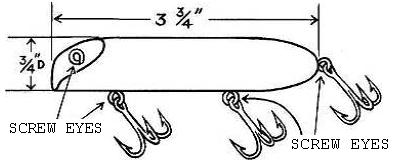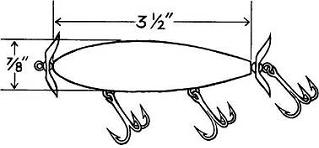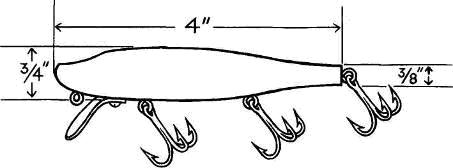|
Freshwater Fishing PlugsBasic Lures You Can Make
|
The fastest way to shape wooden plugs is with a lathe. With a wood-turning lathe or even a metal-turning lathe, for that matter, you can shape the plugs quickly and uniformly in fairly large quantities.
If you already have such a lathe, so much the better. When turning down plugs with a lathe, mount one of the wooden blocks between the centers.
Measure and mark the length of the plug you are making on the wood block with a pencil so you know where both ends will fall.
Then start the lathe and, using the wood-turning tools, shape the wood to the correct diameter, taper, and shape of the model you are copying.
After this is done take some sandpaper and sand the plug very smooth as it is turning. Then cut the finished plug off from the rest of the wood.
If you have no lathe you can turn out plugs at a fair speed with ordinary hand tools. You can whittle plugs from the softer woods with an ordinary sharp knife if you prefer to work that way.
However, a somewhat easier and quicker method is to secure the block of wood in a bench vise and then use a rasp to take off the corners. If you cut the block of wood almost the diameter of the finished plug, you will have less filing to do.
In other words, if the finished plug will be an inch in diameter, start with a block of wood of about the same diameter or a bit more. Then you only have to round off the corners with the rasp.
After using the rasp for the rough work finish shaping the plug with a wood file. Then it can be made smooth by using different grades of sandpaper.
Several basic body shapes are used in making freshwater fishing plugs. An old-time favorite is the wobbler type shown below. This plug is simple to make since it is uniform in thickness with a rounded tail and a grooved head.
It should be about 3 3/4 in. long and 3/4 in. in diameter. The dimensions given for all the wooden plugs here are the so-called "bait-casting" size.
These are fairly large freshwater fishing plugs suitable for use with bait-casting, spin casting, or spinning rods. They weigh about 5/8 of an ounce when finished.
If you want smaller fishing plugs strictly for use with light spinning tackle, make them about one third smaller than the dimensions given here.
Next we have the surface plugs which ride on top of the water and create some kind of commotion, such as a splash or ripple. One of the simplest of these surface fishing plugs is the popper type. Another type of surface fishing plug which was popular many years ago and is still a good fish getter for freshwater fishing is the collar type.
Illustrated above, yet another popular surface plug which has proven effective over the years is the propeller type. There is also a less common, but equally effective freshwater fishing lure and it is the darter type of surface plug.
The strictly underwater plug shown below is an old-time favorite of freshwater fishing consistently through the years.
The large bait-casting size in this plug consists of a body about 4 in. long, 3/4 in. in diameter, and the tail tapers to 3/8 of an inch.
The head part is round with a concave cut on top. This can easily be done with a half-round file or by holding the plug against a revolving grindstone.
If you haven't got the time or desire to turn out the plug bodies with hand tools you can order different types and sizes of finished wood bodies from some of the mail-order houses.
These wooden bodies are already shaped and sanded smooth so that all you have to do is assemble the parts, such as the hardware and hooks.
If you want to make plastic plugs, order such bodies from the mail-order houses. Some of these plastic plugs come complete, all ready for adding the hooks and other metal parts. Others come in two sections and must be cemented together.
Before making the wooden plugs described in this section, decide how you will paint or spray them.
The freshwater fishing plugs described in this page and suggestions for making them are just a starter for the ambitious do-it-yourself angler.
Many different kinds of plug can be made or created. The angler can experiment with plug weights and shapes and work out a freshwater fishing lure most suitable for the waters he fishes.
One angler may want big, strong plugs to use for such large fish as muskellunge, pike, Pacific salmon, etc. Naturally, he will use larger plug bodies, stronger, heavier hooks and heavy hardware and fittings.
Another angler may want small, light lures to use for such small fish as trout, bass, and panfish. He will make much smaller plugs and use lighter hooks and hardware.
Still another angler may want to create a plug which resembles some particular minnow or small animal which fish feed on in the waters he fishes.
All of these anglers can usually meet such demands more exactly by making or designing their own freshwater fishing lures.
| Back to Top |
Make-Your-Own-Fishing-Lures.com
© 2007 Make-Your-Own-Fishing-Lures.com. All Rights Reserved.






